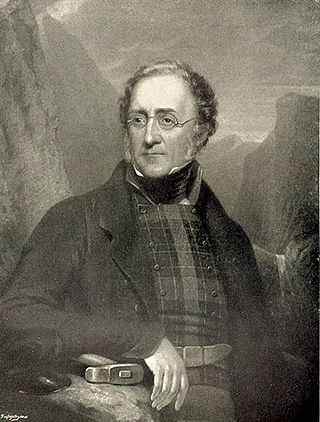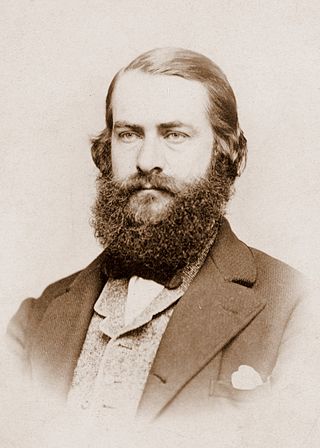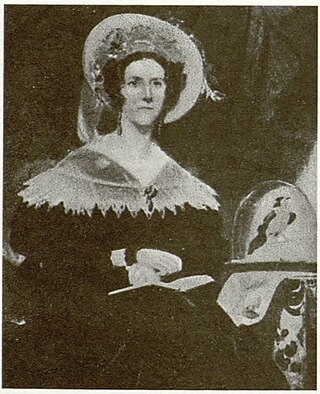
Mary Anning was an English fossil collector, dealer, and palaeontologist. She became known internationally for her discoveries in Jurassic marine fossil beds in the cliffs along the English Channel at Lyme Regis in the county of Dorset, Southwest England. Anning's findings contributed to changes in scientific thinking about prehistoric life and the history of the Earth.

Sir Henry Thomas De la Beche KCB, FRS was an English geologist and palaeontologist, the first director of the Geological Survey of Great Britain, who helped pioneer early geological survey methods. He was the first President of the Palaeontographical Society.

Edward Drinker Cope was an American zoologist, paleontologist, comparative anatomist, herpetologist, and ichthyologist. Born to a wealthy Quaker family, he distinguished himself as a child prodigy interested in science, publishing his first scientific paper at the age of 19. Though his father tried to raise Cope as a gentleman farmer, he eventually acquiesced to his son's scientific aspirations.

Etheldred Anna Maria Benett was an early English geologist who devoted much of her life to collecting and studying fossils that she discovered in South West England. She worked closely with many principal geologists and her fossil collection, considered one of the largest at the time, played a part in the development of geology as a field of science.

Joseph Mellick Leidy was an American paleontologist, parasitologist and anatomist.

Julian Edmund Tenison-Woods, commonly referred to as Father Woods, was an English Catholic priest and geologist who served in Australia. With Mary MacKillop, he co-founded the Sisters of St Joseph of the Sacred Heart at Penola in 1866.

Rosa Smith Eigenmann was an American ichthyologist, as well as a writer, editor, former curator at the California Academy of Sciences, and the first librarian of the San Diego Society of Natural History. She "is considered the first woman ichthyologist in the United States." Eigenmann was also the first woman to become president of Indiana University's chapter of Sigma Xi, an honorary science society. She authored twelve published papers of her own between 1880 and 1893, and collaborated with her husband, Carl H. Eigenmann, as "Eigenmann & Eigenmann" on twenty-five additional works between 1888 and 1893. Together, they are credited with describing about 150 species of fishes.

Protosphyraena is a fossil genus of swordfish-like marine fish, that thrived worldwide during the Cretaceous period (Albian-Maastrichtian). Fossil remains of this taxon are mainly discovered in North America and Europe, and potential specimens are also known from Asia, Africa and Australia. Its fossils are best known from the Smoky Hill Member of the Niobrara Chalk Formation of Kansas.

John James Stevenson was an American geologist, born in New York City. He graduated from New York University in 1863, became professor of chemistry at West Virginia University for two years (1869–71), then served as professor of geology at New York University until 1909. During 1873–74 and from 1878 to 1880 he was geologist for the United States Geological Survey. He also served on the Pennsylvania Geological Survey from 1875 to 1878 and from 1881 to 1882. He was president of the Geological Society of America in 1898.

Benjamin Franklin Mudge was an American lawyer, geologist and teacher. Briefly the mayor of Lynn, Massachusetts, he later moved to Kansas where he was appointed the first State Geologist. He led the first geological survey of the state in 1864, and published the first book on the geology of Kansas. He lectured extensively, and was department chair at the Kansas State Agricultural College.

The Wyck house, also known as the Haines house or Hans Millan house, is a historic mansion, museum, garden, and urban farm in the Germantown neighborhood of Philadelphia, Pennsylvania. It was recognized as a National Historic Landmark in 1971 for its well-preserved condition and its documentary records, which span nine generations of a single family.

Sir Algernon Phillips Withiel Thomas was a New Zealand university professor, geologist, biologist and educationalist. He was born in Birkenhead, Cheshire, England in 1857 and died in Auckland, New Zealand in 1937. He is best known for his early research (1880–83) into the life cycle of the sheep liver fluke, a discovery he shared with the German zoologist Rudolf Leuckart, his report on the eruption of Tarawera (1888) and his contribution to the development of New Zealand pedagogy.

Jane Stephens was an Irish zoologist who was considered a leading authority on sponges in Ireland with specialised knowledge in other marine life who identified and named over 40 sponges new to science. From 1905 to 1920 she was employed in the Natural History Division of the National Museum of Ireland working primarily on the collections of marine invertebrates, including taking part in the Clare Island Survey. Robert Lloyd Praeger testified to her knowledge of and work with Irish sponges stating that "Most of what we know of this group, whether marine or fresh-water, in Ireland, or off the Irish coasts, is due to her work."
Veronica Conroy Burns was an Irish museum curator, best known as an expert on graptolites.

Christian Ramsay, Countess of Dalhousie informally Lady Dalhousie, néeBroun; was a Scottish botanist and natural historian. She married George Ramsay, 9th Earl of Dalhousie and travelled with him when he was appointed Lieutenant Governor of Nova Scotia, Governor General of Canada and Commander in Chief of the Indian Army. While travelling, she collected and catalogued many species of plants, presented scientific papers to societies and donated many collections to different botanical groups.

Helen Vickroy Austin was an American journalist and horticulturist.

James William Davis was a British naturalist who specialised in fossil fish. He lived at Chevinedge, Halifax in Yorkshire. James William Davis was a leading member of the Yorkshire Naturalists' Union and a Fellow of the Geological Society of London.

Ann Fowler Rhoads is an American botanist who worked as a plant pathologist at Morris Arboretum for 36 years, retiring in 2013. She is the co-founder of the Pennsylvania Flora Project of Morris Arboretum. In addition, Rhoads is a former adjunct professor at the University of Pennsylvania and a former Research Associate at the Academy of Natural Sciences.
Reuben Haines III was a Quaker farmer, brewer, abolitionist, scientist, ornithologist, meteorologist, firefighter, philanthropist, and educational reformer from Philadelphia, Pennsylvania.
















